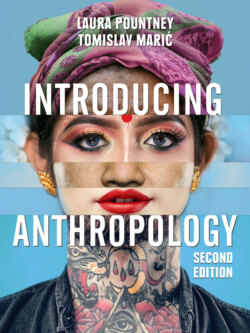Читать книгу Introducing Anthropology - Laura Pountney - Страница 119
Tattooing
ОглавлениеThe skin is the body’s largest organ. Tattooing involves the penetration of the skin with ink in order to stain it permanently with colour – a procedure that is culturally constructed. The word ‘tattoo’ derives from the Polynesian word tatau, meaning ‘to strike’ or ‘to inflict wounds’. In the past, high-status men among the New Zealand Maori and in the Marquesas, in Polynesia, were tattooed all over their bodies. Considerable portions of the body were also tattooed in Samoa, Tahiti, Hawai’i and other Pacific islands, while in the West tattoos were almost always associated with sailors, adventurers and prison inmates. In Japan, tattoos carried an association with gangsters known as Yakuza. Tattoos, in some societies, have been used throughout history to mark someone as an outcast or as someone else’s property. Examples are the tattooing of slaves in ancient Rome, of gangsters in Japan and China, of convicts transported to Australia in the eighteenth and nineteenth centuries, and of Jews in Nazi concentration camps such as Auschwitz. Prostitutes in some parts of Eastern Europe are tattooed or ‘branded’ as an indication of ownership. Today, modern slavery continues the practice of ‘branding’ slaves in some cases. All these practices denied personhood to certain groups of people. This shows how some bodies were and are, in some cases, controlled and labelled as less important and unequal to others.
tattoo A permanent mark or design made on the skin by a process of pricking and ingraining an indelible pigment or by raising scars
body-branding Branding involves burning the skin with hot or cold instruments to produce a permanent design. It is often used to express ownership of other humans
However, since the 1960s, tattooing has become increasingly popular in the West as a statement of individualism, independence, rebellion and fashion or gang culture. Sports people and celebrities have made tattooing a fashion statement and its popularity has increased as a result. Justin Bieber, Harry Styles and Rihanna are just some examples of high-profile celebrities who are heavily tattooed
Anthropologists have always been interested in studying tattooing and how the body is used to express different meanings for individuals and the cultures in which they live. Tattoos are a visible nonverbal way of expressing many things. They are an example of people using their bodies as a canvas. What is chosen for the tattoo is the result of both personal and cultural factors. A tattoo may be a personal symbol, but it also has social meaning.
Tattoos can provide an effective way of communicating many things, such as personal, social or religious characteristics or cultural pride and identity. They can be linked to a transition from one stage of life to another; they can form part of an initiation that marks the passage from boyhood to manhood or from girlhood to womanhood. For some cultures, tattooing is necessary to establish humans as full social beings. The Roro people of Central Province, Papua New Guinea, describe those who are not tattooed as ‘raw’, comparing them to uncooked meat. Maori warriors of New Zealand have facial tattoos (called moko) to intimidate and distract enemies. Throughout history, in many different cultures, tattooing has been a way of creating an identity.
